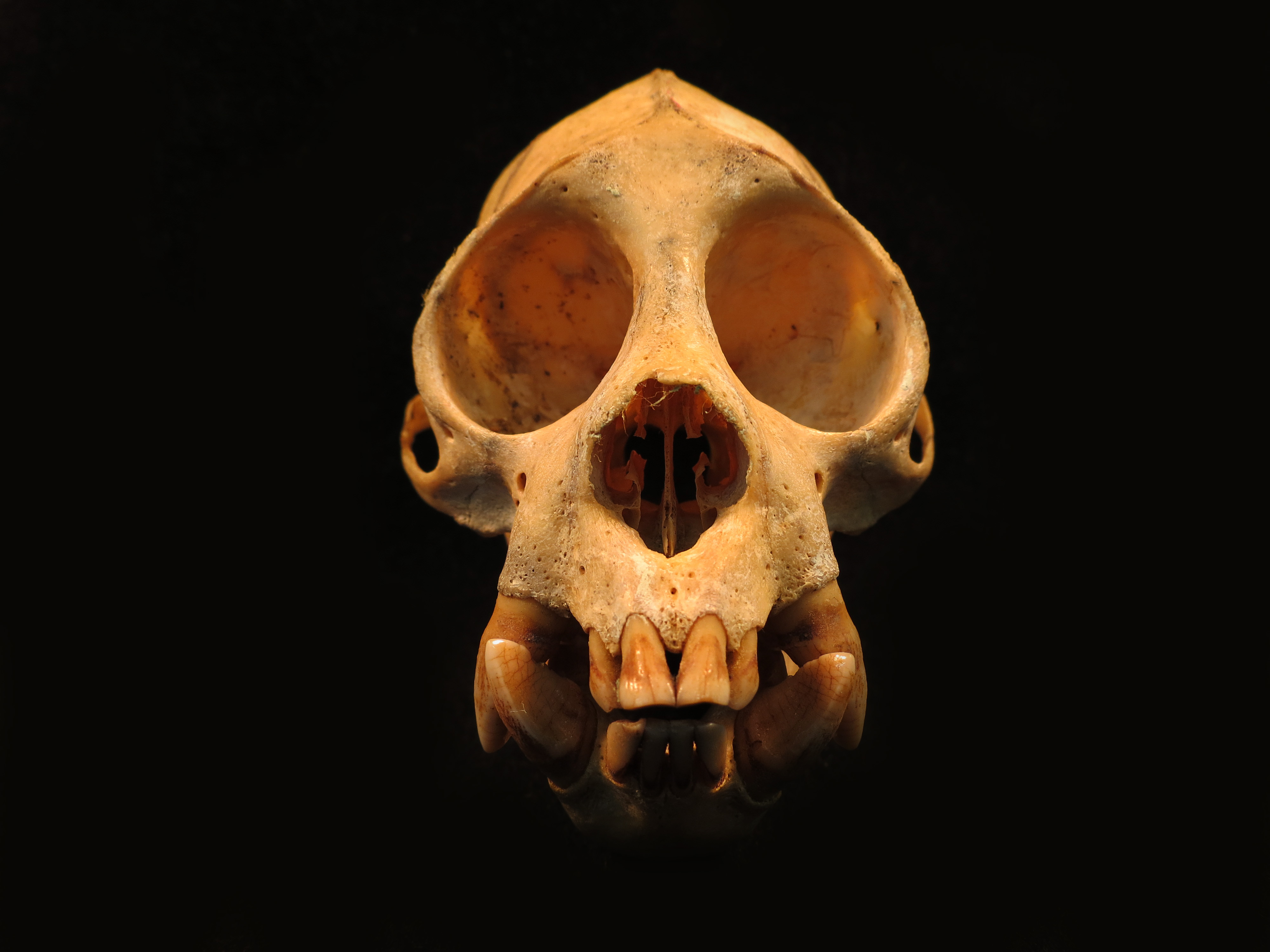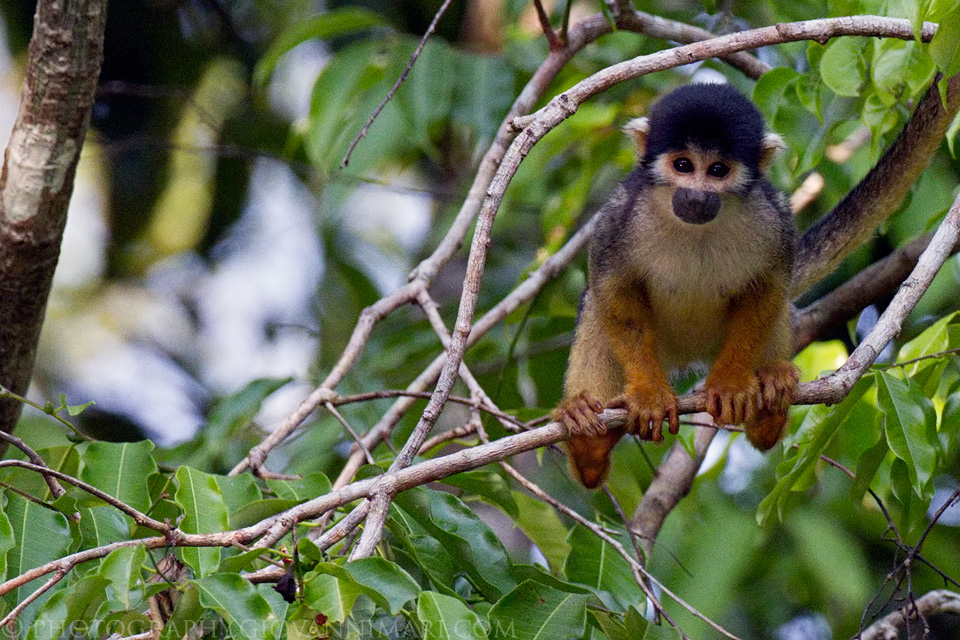|
Cacajao
Uakari (, ) is the common name for the New World monkeys from the genus ''Cacajao''. Both the English and scientific names are believed to have originated from indigenous languages. The uakaris are unusual among New World monkeys in that the tail length (15–18 cm) is substantially less than their head and body length (40–45 cm). Their bodies are covered with long, loose hair but their heads are bald. They have almost no subcutaneous fat, so their bald faces appear almost skull-like. Like their closest relatives the saki monkeys, they have projecting lower incisors. These monkeys have the most striking red facial skin of any primate. Females choose their mates based on how red the male's face is. Evidence suggests that the red facial coloration reflects the health of the primate. The four species of uakari currently recognized are all found in the north-western Amazon basin. The bald uakari, remarkable for its brilliant scarlet complexion, is found north of the Ama ... [...More Info...] [...Related Items...] OR: [Wikipedia] [Google] [Baidu] |
Bald Uakari
The bald uakari (''Cacajao calvus'') or bald-headed uakari is a small New World monkey characterized by a very short tail; bright, crimson face; a bald head; and long coat. The bald uakari is restricted to várzea forests and other wooded habitats near water in the western Amazon Rainforest, Amazon of Brazil and Peru. Taxonomy There are four recognized subspecies of the bald uakari, each of which is considered Vulnerable species, vulnerable to extinction: * White bald-headed uakari, ''Cacajao calvus calvus'' * Ucayali bald-headed uakari, ''Cacajao calvus ucayalii'' * Red bald-headed uakari, ''Cacajao calvus rubicundus'' * Novaes' bald-headed uakari, ''Cacajao calvus novaesi'' However, a literature review of all known occurrence records, followed by a molecular phylogenetic analysis, suggests that these subspecies should be upgraded to species, as well as adding a new species, ''Cacajao amuna'' sp. n. If this is accepted by the wider research community, it could have large imp ... [...More Info...] [...Related Items...] OR: [Wikipedia] [Google] [Baidu] |
Black-headed Uakari
The golden-backed uakari (''Cacajao melanocephalus'') or black-headed uakari, is a New World primate from the family Pitheciidae. It lives in the Amazon Rainforest, and is found in the countries of Brazil, Colombia, and Venezuela. It has black hair covering its body, except for a reddish abdomen, tail, and upper limbs, and a bald face. It has highly specialised teeth which allow it to eat seeds and fruits with hard shells. Taxonomy The species ''Cacajao melanocephalus'' was previously named the black-headed uakari and two subspecies were thought to exist: ''Cacajao melanocephalus melanocephalus'' (black-backed uakari) and ''Cacajao melanocephalus ouakary'' (golden-backed uakari).Hershkovitz, P. (1987). ''Uacaris. New World monkeys of the genus ''Cacajao'' (Cebidae, Platyrrhini): a preliminary taxonomic review with a description of a new sub-species.'' American Journal of Primatology 12: 1–53. However, in 2008 a new black uakari was discovered and the species group was reasses ... [...More Info...] [...Related Items...] OR: [Wikipedia] [Google] [Baidu] |
Aracá Uakari
The Aracá uakari (''Cacajao ayresi''), also known as the Ayres black uakari, is a newly described species of monkey from the northwest Brazilian Amazon. It was found by Jean-Phillipe Boubli of the University of Auckland after following native Yanomamo Indians on their hunts along the Rio Aracá, a northern tributary of the Rio Negro. It was subsequently described in 2008 together with the more westerly distributed Neblina uakari. Until then, the black-headed uakari was the only species of mainly black uakari that was recognized. Stephen F. Ferrari ''et al'' proposed treating the Aracá uakari as a subspecies of the black-headed uakari rather than as a separate species. This monkey is named after Brazilian biologist José Márcio Ayres, formerly a senior zoologist for the Wildlife Conservation Society. José Márcio Ayres, who died in 2003, pioneered studies in uakaris and played a fundamental role in the creation of the Mamirauá Sustainable Development Reserve, which is of ... [...More Info...] [...Related Items...] OR: [Wikipedia] [Google] [Baidu] |
Neblina Uakari
The Neblina uakari (''Cacajao hosomi'') or black-headed uakari, is a newly described species of monkey from the far northwest Brazilian Amazon and adjacent southern Venezuela. It was found by Jean-Phillipe Boubli of the University of Auckland and described together with the more easterly distributed Aracá uakari in 2008. Until then, the black-headed uakari (found to the west and south of the Neblina uakari) was the only species of mainly black uakari that was recognized. The English name of the Neblina uakari refers to the Pico da Neblina, which marks the approximate center of its known distribution. Several years before it was realized it represented an undescribed species (and not "just" black-headed uakaris), it was studied in the Pico da Neblina National Park Pico da Neblina National Park () is a national park in the state of Amazonas in the north of Brazil, bordering on Venezuela. It overlaps with several indigenous territories, which creates tensions over land use, as ... [...More Info...] [...Related Items...] OR: [Wikipedia] [Google] [Baidu] |
Mamirauá Sustainable Development Reserve
The Mamirauá Sustainable Development Reserve () in the Brazilian state of Amazonas (Brazilian state), Amazonas, near the city of Tefé, is a reserve near the village of Boca do Mamirauá. It includes mostly Amazon rainforest, Amazonian flooded forest and wetlands. The ribeirinhos are native to the area. Location The Mamirauá Sustainable Development Reserve is divided between the municipalities of Uarini (18.68%), Tonantins (1.24%), Maraã (26.74%), Japurá (1.33%) and Fonte Boa, Amazonas, Fonte Boa (52.01%) in the state of Amazonas. It has an area of . It covers the elongated triangle between the Solimões River (Upper Amazon) to the south, the Auati-Paraná Canal, which leaves the Solimões and meanders in a generally eastward direction to join the Japurá River to the north, and the Japurá from the junction with the Auati-Paraná to the point where it joins the Solimões. It adjoins the Auatí-Paraná Extractive Reserve to the north. The Amanã Sustainable Development Reser ... [...More Info...] [...Related Items...] OR: [Wikipedia] [Google] [Baidu] |
Alexander Von Humboldt
Friedrich Wilhelm Heinrich Alexander von Humboldt (14 September 1769 – 6 May 1859) was a German polymath, geographer, natural history, naturalist, List of explorers, explorer, and proponent of Romanticism, Romantic philosophy and Romanticism in science, science. He was the younger brother of the Prussian minister, philosopher, and linguistics, linguist Wilhelm von Humboldt (1767–1835). Humboldt's quantitative work on botany, botanical geography laid the foundation for the field of biogeography, while his advocacy of long-term systematic geophysical measurement pioneered modern Earth's magnetic field, geomagnetic and meteorology, meteorological monitoring. Humboldt and Carl Ritter are both regarded as the founders of modern geography as they established it as an independent scientific discipline. Between 1799 and 1804, Humboldt travelled extensively in the Americas, exploring and describing them for the first time from a non-Spanish European scientific point of view. His des ... [...More Info...] [...Related Items...] OR: [Wikipedia] [Google] [Baidu] |
Solimões River
Solimões () is the name often given to upper stretches of the Amazon River in Brazil from its confluence with the Rio Negro upstream to the border of Peru. The Solimões flows for about 1,600 km (1,000 miles) through a floodplain about 80 km (50 miles) wide. Geography The Amazon / Solimões river just above the confluence of the Solimões and Rio Negro is already by far the largest river in the world, even though its two largest tributaries (the Negro and the Madeira River) have not yet contributed to the flow volume. The Solimões portion of the Amazon River lies entirely in the state of Amazonas, Brazil, and some portion of the state is often referred to as the "Solimões region". The ecoregion of the Solimões River drainage basin is entirely tropical rainforest. Etymology An Amazonian aboriginal nation called ''Soriman'' was corrupted in Portuguese to ''Solimão'' and ''Soliemoens'', from which the name of this section of the river and the region it drains is derived. ... [...More Info...] [...Related Items...] OR: [Wikipedia] [Google] [Baidu] |
Most Recent Common Ancestor
A most recent common ancestor (MRCA), also known as a last common ancestor (LCA), is the most recent individual from which all organisms of a set are inferred to have descended. The most recent common ancestor of a higher taxon is generally assumed to have been a species. The term is also used in reference to the ancestry of groups of genes (haplotypes) rather than organisms. The ancestry of a set of individuals can sometimes be determined by referring to an established pedigree, although this may refer only to patrilineal or matrilineal lines for sexually-reproducing organisms with two parents, four grandparents, etc. However, in general, it is impossible to identify the exact MRCA of a large set of individuals, but an estimate of the time at which the MRCA lived can often be given. Such ''time to most recent common ancestor'' (''TMRCA'') estimates can be given based on DNA test results and established mutation rates as practiced in genetic genealogy, or by reference to a non- ... [...More Info...] [...Related Items...] OR: [Wikipedia] [Google] [Baidu] |
Phylogeography
Phylogeography is the study of the historical processes that may be responsible for the past to present geographic distributions of genealogical lineages. This is accomplished by considering the geographic distribution of individuals in light of genetics, particularly population genetics. This term was introduced to describe geographically structured genetic signals within and among species. An explicit focus on a species' biogeography/biogeographical past sets phylogeography apart from classical population genetics and phylogenetics. Past events that can be inferred include population expansion, population bottlenecks, vicariance, dispersal, and human migration, migration. Recently developed approaches integrating coalescent theory or the genealogical history of alleles and distributional information can more accurately address the relative roles of these different historical forces in shaping current patterns. Historical development The term phylogeography was first used by Joh ... [...More Info...] [...Related Items...] OR: [Wikipedia] [Google] [Baidu] |
Venezuela
Venezuela, officially the Bolivarian Republic of Venezuela, is a country on the northern coast of South America, consisting of a continental landmass and many Federal Dependencies of Venezuela, islands and islets in the Caribbean Sea. It comprises an area of , and its population was estimated at 29 million in 2022. The capital and largest urban agglomeration is the city of Caracas. The continental territory is bordered on the north by the Caribbean Sea and the Atlantic Ocean, on the west by Colombia, Brazil on the south, Trinidad and Tobago to the north-east and on the east by Guyana. Venezuela is a presidential republic consisting of States of Venezuela, 23 states, the Venezuelan Capital District, Capital District and Federal Dependencies of Venezuela, federal dependencies covering Venezuela's offshore islands. Venezuela is among the most urbanized countries in Latin America; the vast majority of Venezuelans live in the cities of the north and in the capital. The territory o ... [...More Info...] [...Related Items...] OR: [Wikipedia] [Google] [Baidu] |


